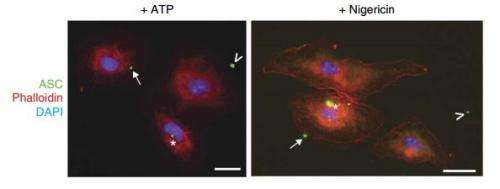June 23, 2014 report
Researchers find ASC specks released by cells eaten by other immune cells leads to multiplying inflammation

(Medical Xpress)—Two teams of researchers, one working in Spain, the other in Germany have independently discovered a connection between ASC specks released by macrophages during cell death and ingestion by other macrophages that can lead to multiplying inflammation. Both teams have published their findings in the journal Nature Immunology.
Inflammation in the body can be a good thing, helping to heal, but in many cases, it can be a bad thing, causing harm rather than good. Pneumonia, for example, is one prominent example of inflammation gone awry. Another instance where it occurs is in some autoimmune diseases, where the body fights itself, quite often using inflammation as a tool. The two teams in Europe have now found one of the mechanisms responsible for multiplying inflammation, which is where inflammation spreads beyond a localized area, seemingly, without a good reason.
ASC specks are molecular assemblages (consisting mostly of protein that is necessary for cytokines' maturation and an inflammasome protein) that exist inside of cells, in this case, immune cells known as macrophages. Prior research had suggested they remained inside of such cells, doing their work, helping to clear out tissue debris and stimulating inflammation. The teams involved in the two new studies have found that ASC specks are able to leave their macrophage cells when the host dies and travel a short distance upon which they are ingested by other macrophage cells. When that happens, the cell that eats the speck is stimulated, instigating an immune response and associated inflammation. Once that happens, the secondary macrophages can release some of the ASC specks, which travel and are ingested by other macrophages, and on and on, which the teams report, helps explain how multiplying inflammation occurs.
If ASC specks travel, both teams note, and cause inflammation to spread, it might be possible to develop a drug that prevents them from doing so, thus preventing inflammation from spreading.
The team in Spain investigated ASC speck levels in patients with inflammatory disorder cryopyrin-associated periodic syndromes. They found that levels were only elevated during times of flare-ups. The team in Germany studied the impact of ASC specks on inflammatory lung diseases related to smoking and found that test mice with the disease had greater quantities of ASC speck outside of microphages than mice without such diseases.
Both teams note also that their findings suggest that ASC speck analysis in patients could also serve as a marker, alerting physicians to the onset of inflammatory disease before it becomes apparent.
More information: The adaptor ASC has extracellular and 'prionoid' activities that propagate inflammation, Nature Immunology (2014) DOI: 10.1038/ni.2913
The NLRP3 inflammasome is released as a particulate danger signal that amplifies the inflammatory response, Nature Immunology (2014) DOI: 10.1038/ni.2919
© 2014 Phys.org
















